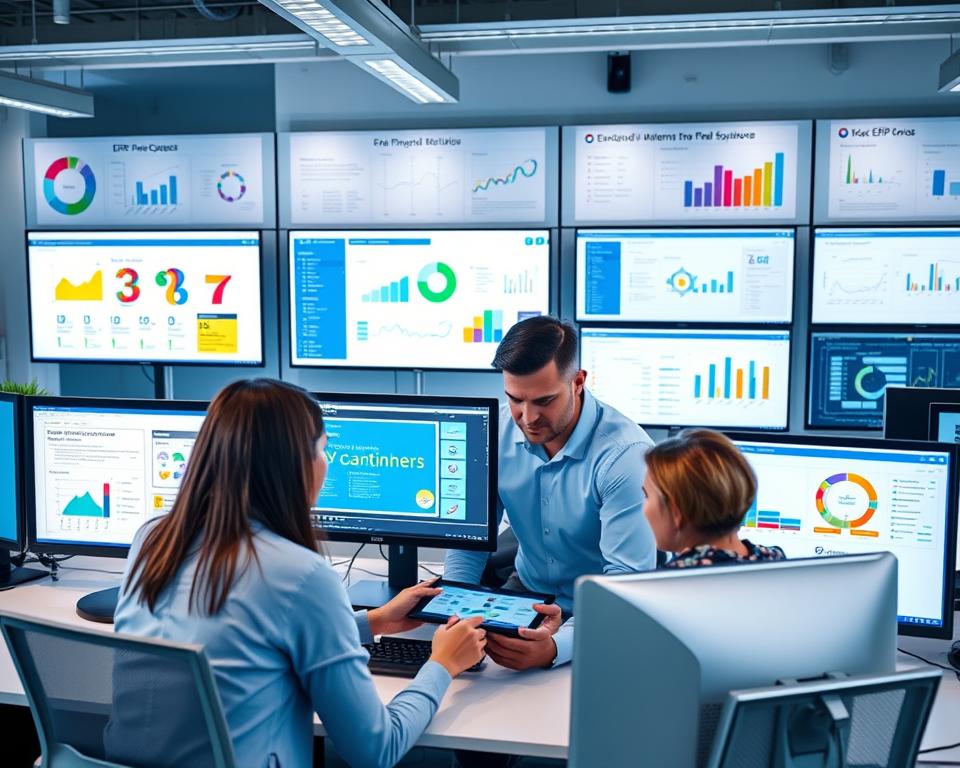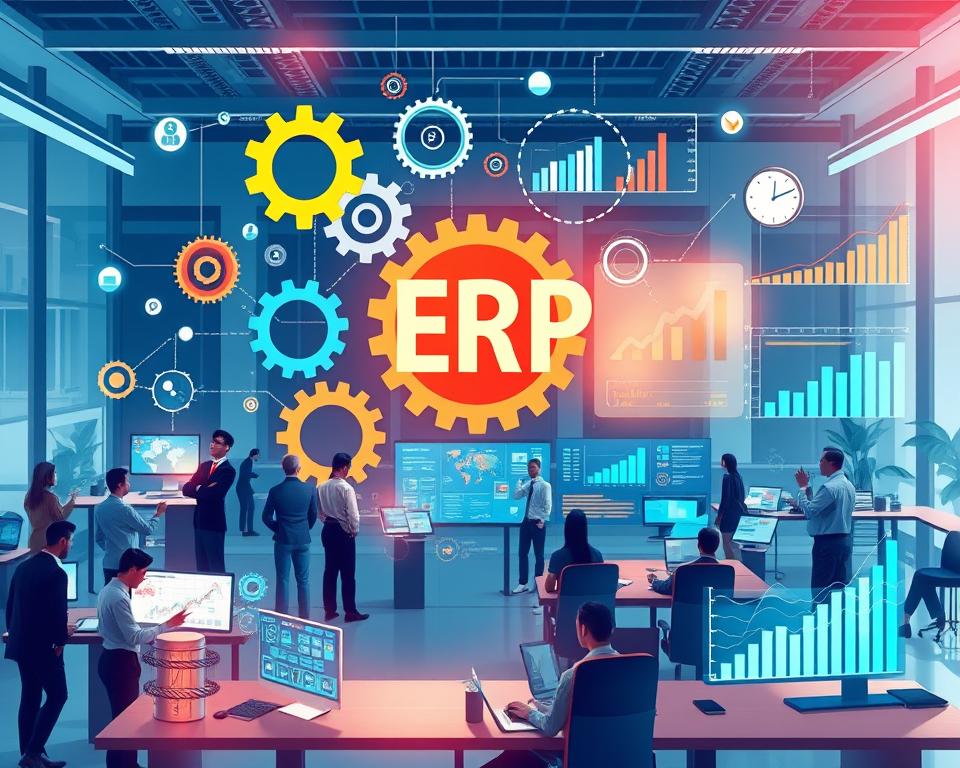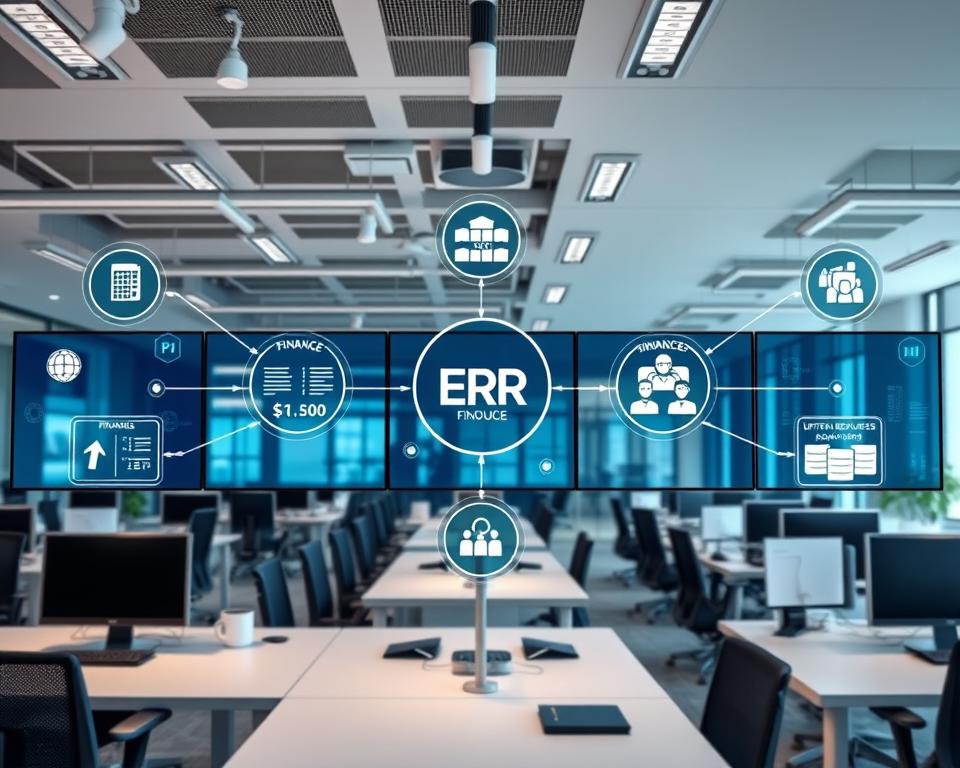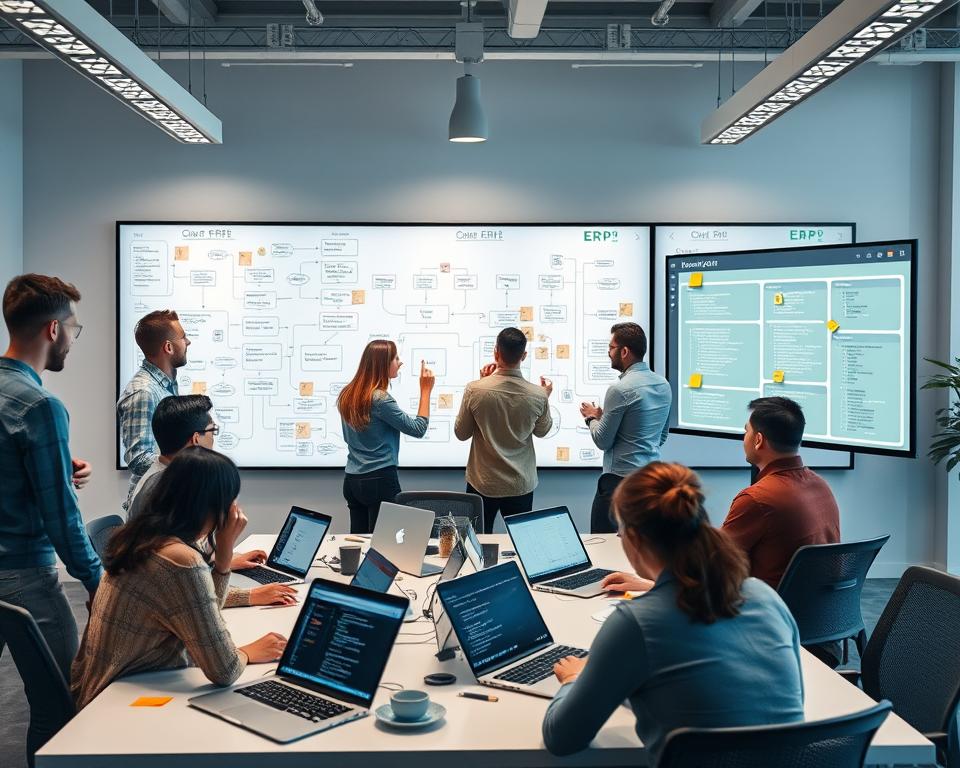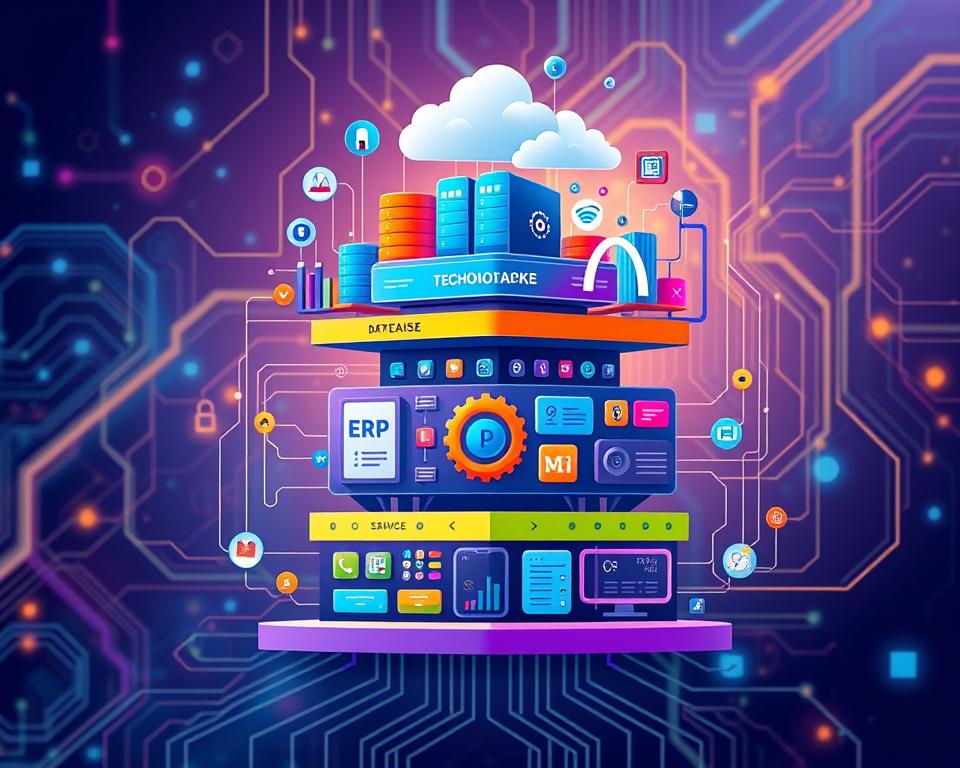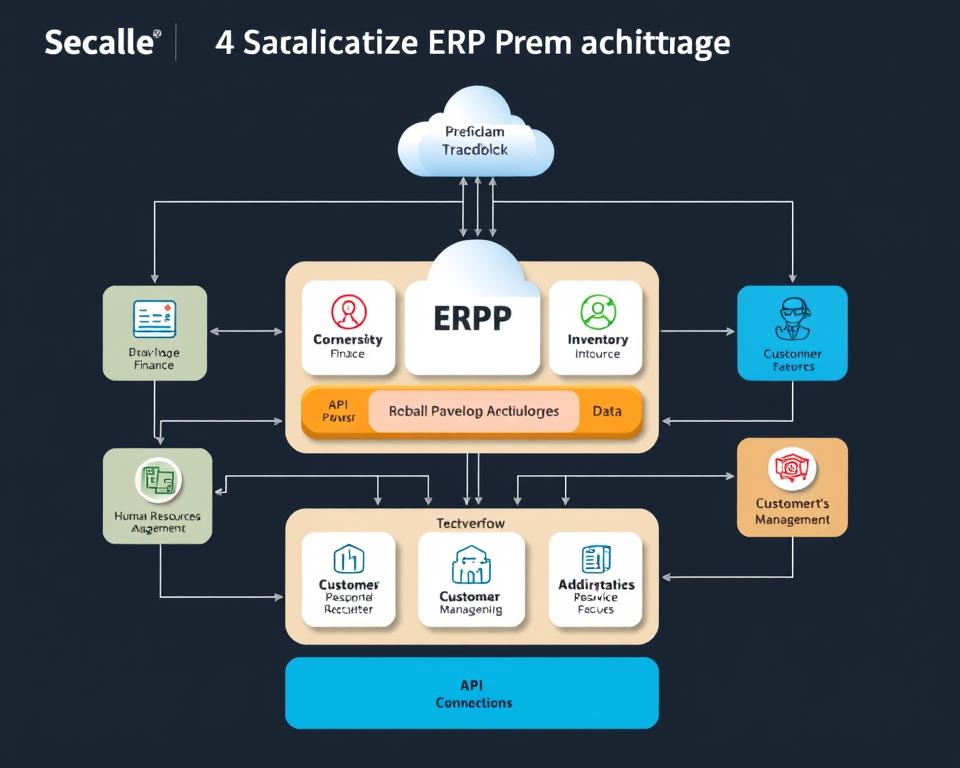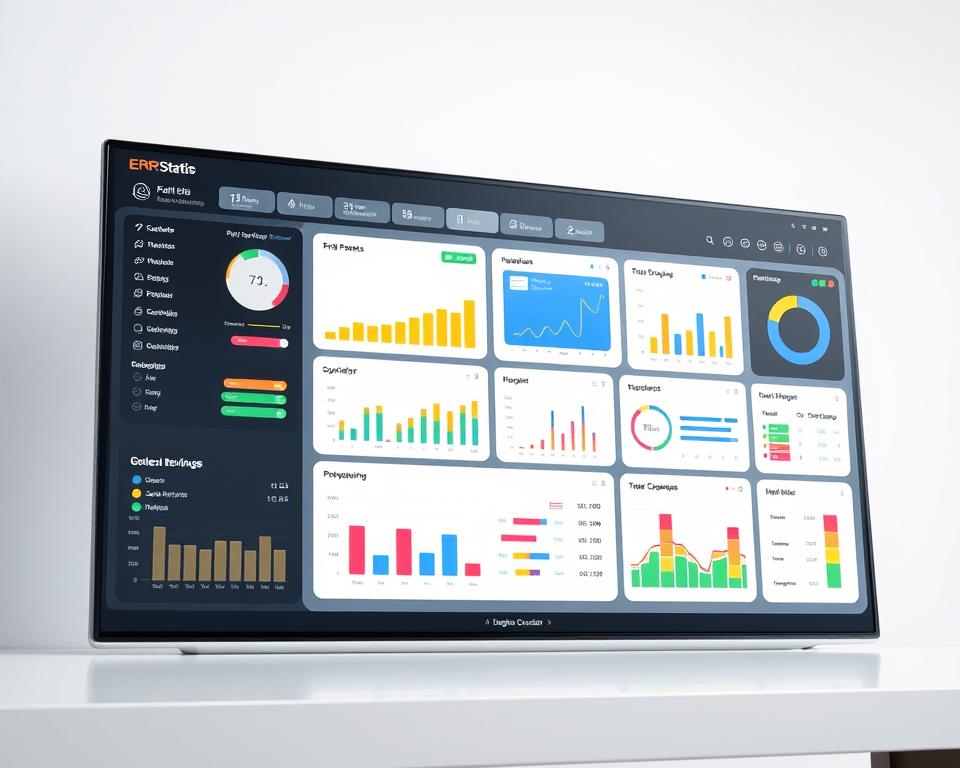Medium-sized companies face many challenges in today’s fast-paced business world. As they grow, they often need better systems and processes. This guide will show you how to create a custom ERP system for mid-market companies.
This system can make operations smoother, improve efficiency, and help your business grow. It’s a key step for any company looking to succeed.
Table of Contents
Key Takeaways
- Understand the benefits and importance of custom ERP solutions for medium-sized businesses
- Assess your organization’s specific requirements and pain points to guide the ERP development process
- Identify the core modules and functionalities essential for a mid-market ERP system
- Evaluate the technology stack and architectural design to ensure scalability and integration
- Develop a comprehensive implementation strategy, including testing, training, and change management
Understanding ERP Solutions and Their Importance for Mid-Market Companies
Enterprise Resource Planning (ERP) systems are changing the game for businesses of all sizes. They are especially valuable for medium-sized companies, or the mid-market. These ERP solutions offer many benefits. They help mid-market companies improve their business processes, increase productivity, and get a good return on investment (ROI).
Key Benefits of Custom ERP Implementation
Custom ERP solutions are a big plus for mid-market companies. They are made to meet the unique needs of these businesses. These solutions make operations smoother, improve data management, and help make better decisions in areas like finance, inventory, and human resources.
Common Challenges Faced by Medium-Sized Businesses
Mid-market companies face unique challenges. They often have limited resources, deal with complex rules, and need to stay competitive. A tailored ERP system can help solve these mid-market challenges. It gives the tools and insights needed to boost efficiency, meet regulations, and grow strategically.
The ROI of Tailored ERP Systems
The return on investment (ROI) of a custom ERP solution for mid-market businesses is significant. These systems make operations more efficient, improve data visibility, and optimize business process optimization. This leads to cost savings, higher productivity, and better decision-making, helping to strengthen the bottom line.
“A well-designed ERP system can transform the way mid-market companies operate, unlocking new levels of efficiency and profitability.”
Assessing Your Business Requirements and Pain Points
Creating a custom ERP solution starts with knowing your business inside out. You need to do a deep business analysis. This means mapping out your business processes and finding where a custom ERP can make a big difference.
Process mapping helps you see how your business works now. It shows where things can be better. This helps you figure out what your ERP needs to have.
Finding your pain points is also key. These are the problems your current systems and processes can’t solve. Fixing these will make your business run smoother and more efficiently.
| Common Pain Points | Potential ERP Solution Benefits |
|---|---|
| Inefficient data management and reporting | Streamlined data integration, real-time analytics, and comprehensive reporting capabilities |
| Lack of visibility into inventory levels and supply chain | Improved inventory control, demand forecasting, and supply chain optimization |
| Difficulty in coordinating cross-departmental workflows | Enhanced process automation, task management, and collaboration tools |
By assessing your business requirements and pain points carefully, you can make sure your ERP solution fits your business perfectly. This sets you up for a successful implementation and long-term success.
Core Modules Essential for Medium-Sized Business ERP Systems
Medium-sized businesses face many challenges as they grow. A well-tailored ERP system is key. It makes operations smoother, boosts efficiency, and helps achieve long-term goals. The three main modules for mid-market ERP systems are financial management, inventory control, and HR integration.
Financial Management Components
The financial module is the heart of any ERP system for medium-sized businesses. It includes accounting, budgeting, invoicing, and managing cash flow. Automating these financial tasks leads to better accuracy, quicker reports, and smarter decisions.
Inventory Control Features
Good inventory management is vital for a solid ERP system. The inventory module should show stock levels in real-time, track the supply chain, and help with order fulfillment. This helps mid-market companies manage their stock better, cut waste, and please their customers more.
Human Resource Management Integration
HR management is crucial in an ERP system for medium-sized businesses. It handles tasks like hiring, payroll, tracking work hours, and managing performance. This module makes HR tasks easier, boosts employee happiness, and keeps the company in line with labor laws.
By adding these core modules to their ERP systems, medium-sized businesses can achieve better efficiency, financial control, and flexibility. This sets them up for success and growth in the long run.
How to Build a Tailored ERP Solution for Medium-Sized Businesses
Creating a tailored ERP solution for medium-sized businesses needs careful planning. The ERP development process involves detailed planning, agile project management, and knowing your business’s specific custom software creation needs.
To make a successful tailored ERP solution, follow these steps:
- Do a thorough business analysis to find out what your business needs, its challenges, and goals.
- Make a clear project plan that fits your agile methodology. It should make sure the ERP system solves your unique problems.
- Get a team of ERP experts, including business analysts, developers, and project managers. This ensures smooth custom software creation.
- Use an iterative and incremental development method. This lets you get feedback and make improvements as you go through the ERP development process.
- Do thorough testing to check if the ERP system works well, performs well, and is secure.
- Make a detailed training program. This helps your employees use the tailored ERP solution to its fullest.
- Set up a strong maintenance and support plan. This keeps your ERP system updated and ready for your business’s changing needs.
By taking these steps and using the right agile methodology and project management practices, you can create a tailored ERP solution. This solution will help your medium-sized business run smoother, make better decisions, and grow in a sustainable way.
“The key to building a truly effective ERP solution lies in understanding the unique needs of your business and crafting a tailored solution that addresses those needs head-on.”
Selecting the Right Technology Stack for Your ERP Solution
Choosing the right technology stack for your ERP solution is crucial. It affects the system’s performance, scalability, and security. Each part of the stack, from database management to security, must match your business needs.
Database Management Systems
The database is the heart of your ERP system. You need to consider data volume, transaction rates, and concurrency. For mid-market ERP, PostgreSQL, MySQL, and Microsoft SQL Server are top choices. They offer great scalability, reliability, and features.
Development Frameworks and Tools
Choosing the right development tools is key for a smooth ERP implementation. For the front-end, React, Angular, and Vue.js are popular. For the back-end, Spring Boot, .NET Core, and Laravel are favored. These tools help in building scalable and maintainable systems.
Security Protocols and Standards
Cybersecurity is vital for ERP systems. Use HTTPS, OAuth, and two-factor authentication to protect your data. Also, follow data privacy laws like GDPR and HIPAA to avoid legal issues.
By picking the right technology stack, medium-sized businesses can create a custom ERP solution. It will meet their specific needs, grow efficiently, and keep their data safe.
Creating a Scalable Architecture Design
For medium-sized businesses, designing a scalable ERP architecture is key. It helps future-proof technology investments. The secret is using a modular development approach. This lets the system grow and change with the business.
At the core of a scalable ERP architecture is modularity. Breaking down the ERP into separate, working parts makes it easy to add or change features. This keeps the system flexible and ready for changes in business, market, or rules.
- First, pick the essential ERP modules for your business, like finance, inventory, and HR.
- Then, build these modules as separate units that can talk to each other through clear interfaces.
- Use microservices architecture to make your ERP system more scalable and strong.
- Also, have a solid plan for managing data, including a big database and good data sharing.
By choosing a modular, scalable ERP architecture, medium-sized businesses stay agile. They can quickly meet new market needs and chances.
| Key Considerations for Scalable ERP Architecture | Benefits |
|---|---|
| Modular design with interoperable components | Easily add, modify, or remove functionalities as needed |
| Microservices-based architecture | Enhance system resilience and enable faster updates |
| Scalable data management infrastructure | Support growing data volumes and business requirements |
“A scalable ERP architecture is the foundation for a future-proof technology solution that can grow with your business.”
Integration Capabilities with Existing Business Systems
Medium-sized businesses need a tailored ERP solution. They must integrate it smoothly with their current apps. This ensures a cohesive and efficient business setup. We’ll look at API development and management and data migration strategies for this integration.
API Development and Management
Strong API development is vital for linking the new ERP with old apps and third-party tools. Secure and scalable APIs help in smooth data exchange and workflow automation. This makes sure the integration stays reliable and secure over time.
Data Migration Strategies
Moving data from old systems to the new ERP is key. Good data migration strategies are needed for a smooth transfer. This includes finding data sources, mapping data, and cleaning it to keep it accurate.
| Integration Capability | Importance | Key Considerations |
|---|---|---|
| API Development and Management | Enables seamless data exchange and workflow automation between ERP and legacy systems | Secure, scalable, and well-documented APIs; effective API lifecycle management |
| Data Migration Strategies | Ensures successful and reliable transfer of critical business data to the new ERP platform | Comprehensive data mapping, validation, and cleansing; minimized data loss or corruption |
“Seamless integration between the new ERP system and existing business applications is essential for medium-sized enterprises to maximize the benefits of their tailored solution.”
User Interface Design and Experience Optimization
Building an ERP for medium-sized businesses means focusing on the user interface (UI) and user experience (UX). A good intuitive interface makes your user-friendly ERP easy to use. This helps employees work better and faster.
To make a great UI/UX design for your ERP, consider these important points:
- Simplicity and Clarity: Make the interface easy to understand with clear labels and simple workflows.
- Responsive Design: Make sure your ERP works well on different devices and screen sizes.
- Personalization Options: Let users change their dashboard and settings to fit their needs.
- Contextual Help and Guidance: Add tools and tutorials to help employees use the system fully.
By focusing on the user experience and creating an intuitive interface, you can get more employees using the system. This leads to a more productive team. Your business will see better results and a good return on investment.
| Key UI/UX Design Principles | Description |
|---|---|
| Consistency | Keep the look and feel of the ERP system the same everywhere. |
| Responsiveness | Make sure the ERP looks good on all devices and screen sizes. |
| Accessibility | Make the UI easy for everyone to use, including those with disabilities. |
| Efficiency | Make workflows simple and fast to help employees do their jobs better. |
| Feedback and Error Handling | Give clear feedback and handle errors well. |
By following these UI/UX design principles, you can make an ERP system that looks good and works well. This will help more employees use it, making your investment worth it.
Testing and Quality Assurance Procedures
Having a strong ERP testing and quality assurance (QA) plan is key for your ERP solution’s success. This detailed approach finds and fixes problems before the system goes live. It makes sure the system works well and is safe.
Performance Testing Methods
It’s vital to test the ERP system’s performance. This means checking how it handles different loads and how well it scales. Tests like stress and load testing help see if the system can handle high usage without problems.
Security Testing Protocols
Keeping the ERP system safe from hackers is a major goal. Detailed security audits are needed to find and fix weak spots. These checks make sure the system follows strict security protocols. They include tests to see if the system can stop attacks and keep data safe.
| Testing Technique | Objective | Key Considerations |
|---|---|---|
| Performance Testing | Evaluate system responsiveness, scalability, and stability under various load conditions | Identify peak usage patterns, optimize resource allocation, and ensure seamless user experience |
| Security Testing | Identify and mitigate vulnerabilities to protect the ERP system from cyber threats | Validate access controls, data encryption, and incident response procedures to maintain data integrity and compliance |
“Comprehensive testing and quality assurance are the cornerstones of a successful ERP implementation, ensuring the system meets the unique requirements of your medium-sized business.”
Implementation Strategy and Timeline Planning
Setting up a new ERP (Enterprise Resource Planning) system is a big task. It needs careful planning and action. To make the ERP implementation work, businesses must have a solid plan and a realistic project timeline.
One good way is to use a phased rollout for the new ERP system. This method helps by breaking the setup into smaller steps. It reduces the impact on daily work. By adding departments or functions one at a time, the change can be smoother. This way, any problems can be found and fixed fast.
- Set clear goals and deadlines for each part of the ERP implementation process.
- Make sure to have enough time for change management like training and talking to employees. This helps the transition go smoothly.
- Choose important signs of success (KPIs) to check how well the setup is going. Make changes if needed.
- Have a plan ready for any unexpected problems or delays during the project timeline.
“Successful ERP implementation is not just about the technology, but also about effectively managing the human aspects of change.”
By planning a smart and phased ERP implementation, companies can reduce problems. They can make the change smooth and get the most out of their new system.
Training and Change Management Processes
Getting a new enterprise resource planning (ERP) system is a big deal. It needs careful planning and execution. The key to a successful ERP is training and change management. These steps make sure employees are ready and can use the new system well.
Employee Onboarding Programs
Good employee onboarding is key for a smooth ERP rollout. These programs should teach employees about the new system. They should include training, workshops, and support to make sure everyone feels ready.
- Make training specific to each role to meet different needs.
- Keep training going to help with any problems that come up.
- Have a team of ERP experts ready to help when needed.
Documentation and Support Materials
Having good documentation and support is also important. These resources should be easy for employees to find. They should cover everything from how to use the system to solving problems.
- Make detailed manuals and guides for the ERP system.
- Have a FAQ section for common questions and concerns.
- Offer online tutorials, videos, and webinars for extra learning.
By focusing on training and change management, companies can make the ERP transition smooth. This leads to better user adoption and long-term success with the ERP system.
| Key Elements | Benefits |
|---|---|
| Employee Onboarding Programs | Increased user adoption, improved productivity, and reduced resistance to change |
| Comprehensive Documentation and Support Materials | Easy access to information, reduced support requests, and improved user satisfaction |
Maintenance and Support Planning
Keeping an ERP system running smoothly is key for medium-sized businesses. It’s important to have ongoing ERP maintenance, regular system updates, and dependable technical support. This ensures your ERP stays effective over time. A good maintenance plan helps your ERP grow with your business.
Updates are needed to keep your system safe and add new features. Working with a skilled ERP service provider makes updates easier. They keep your system current and secure.
Having reliable technical support is vital. It helps avoid downtime and lets your team use the ERP well. You might need a help desk, on-site support, or detailed training and guides.
To keep improving, regularly check how your ERP is doing and listen to your team. A clear way to find and fix problems helps make your ERP better for your business.
| ERP Maintenance Best Practices | Benefits |
|---|---|
| Scheduled system updates | Improved security, bug fixes, and new features |
| Responsive technical support | Minimized downtime and enhanced user experience |
| Continuous improvement processes | Alignment with evolving business needs |
Focus on ERP maintenance, system updates, technical support, and continuous improvement. This way, your ERP will stay a strong tool for growth and efficiency in your medium-sized business.
Cost Analysis and Budget Considerations
When planning an ERP implementation project, it’s crucial to conduct a thorough ERP cost analysis and budget planning. This ensures you allocate the necessary resources and effectively manage the project’s financial aspects. Let’s explore the key considerations for your ERP solution’s initial development expenses and ongoing maintenance costs.
Initial Development Expenses
The initial development expenses for your custom ERP solution can include:
- Software licensing and subscription fees
- Hardware and infrastructure costs
- Implementation and configuration services
- Data migration and integration efforts
- Training and change management programs
Accurately estimating these upfront costs is essential for budget planning and ensuring your ERP project stays within the allocated budget.
Ongoing Maintenance Costs
In addition to the initial development expenses, you’ll also need to account for the ongoing maintenance costs of your ERP system. These may include:
- Software updates and patches
- System maintenance and support
- Hardware and infrastructure upgrades
- Ongoing user training and change management
By carefully estimating the total cost of ownership (TCO) and return on investment (ROI) of your ERP solution, you can make informed decisions and ensure the long-term sustainability of your investment.
| Cost Category | Estimated Amount |
|---|---|
| Initial Development Expenses | $150,000 – $300,000 |
| Ongoing Maintenance Costs | $30,000 – $60,000 per year |
Remember, the actual costs may vary depending on the complexity of your business requirements, the scope of the ERP implementation, and the vendor or service provider you choose. By carefully planning and budgeting, you can ensure your ERP project delivers the desired benefits and value to your medium-sized business.
Measuring Success and KPI Tracking
Getting a tailored ERP solution is a big deal for medium-sized businesses. It’s key to check if the system is doing what it’s supposed to. This means setting up key performance indicators (KPIs) and watching how the system does. This way, you can make sure your ERP is worth the investment.
When it comes to ERP performance metrics, some top KPIs are:
- Inventory turnover
- Order fulfillment rate
- On-time delivery percentage
- Financial reporting accuracy
- Employee productivity
- User satisfaction
Tracking these KPI tracking metrics gives you important insights. You can see how your ERP system is really helping your business. This info helps you find ways to get even better and keep your ERP working for you.
“Measuring the success of an ERP implementation is essential for medium-sized businesses to ensure they are getting the most out of their investment. KPIs provide the data-driven insights needed to optimize performance and drive ongoing success.”
To really know if your ERP is working, you need to pick the right ERP performance metrics. These should match your business goals. By keeping an eye on these KPIs and using what you learn, you can make your ERP system even better. This will help your company grow and stay profitable over time.
Conclusion
Implementing a custom ERP solution can change the game for medium-sized businesses. It brings many benefits and sets them up for long-term growth. Custom ERP systems help solve specific problems, making operations smoother and decisions better.
Success comes from understanding what your business needs, choosing the right technology, and planning carefully. With ERP, companies can get ahead, transform their business, and stay competitive.
The path to a custom ERP is key for lasting growth and innovation. By creating a solution that fits their needs, businesses can become more efficient and agile. This sets them up for success in a changing world.







